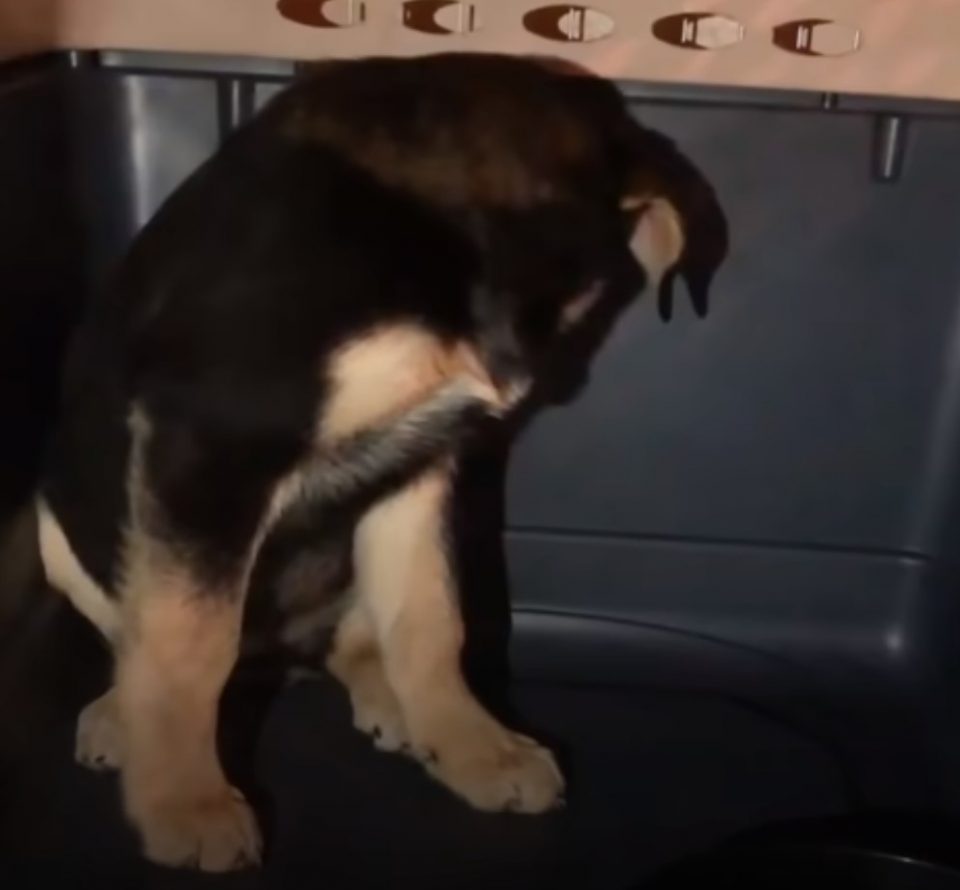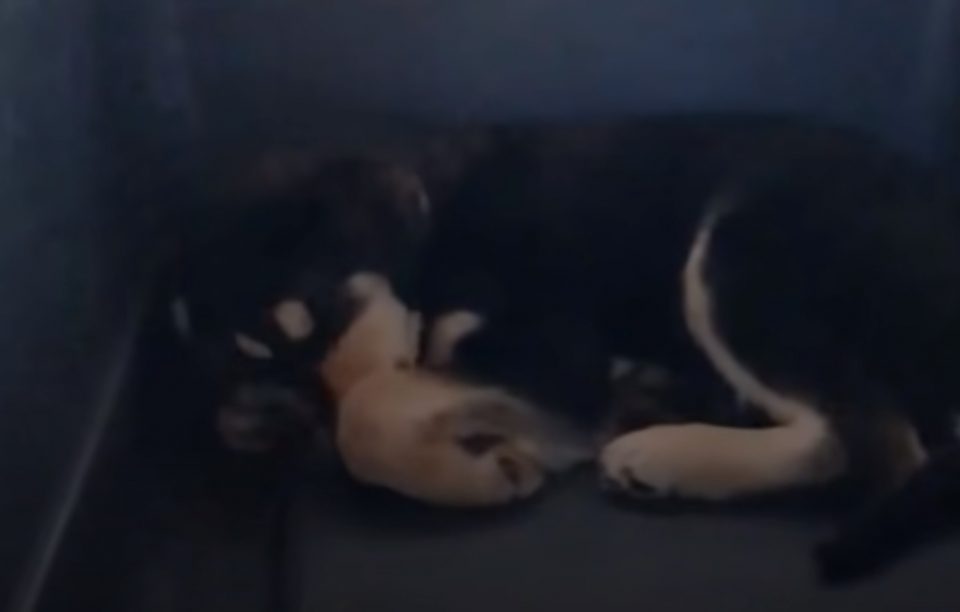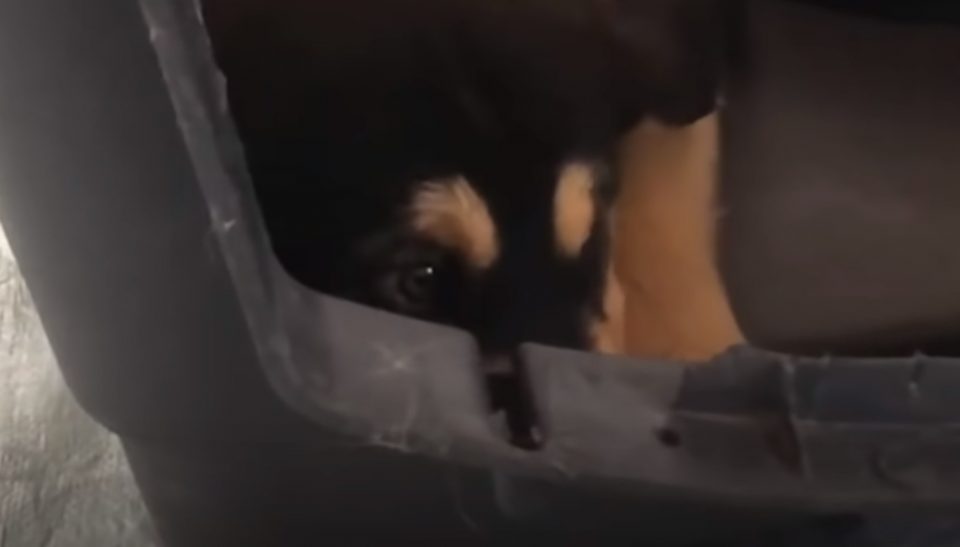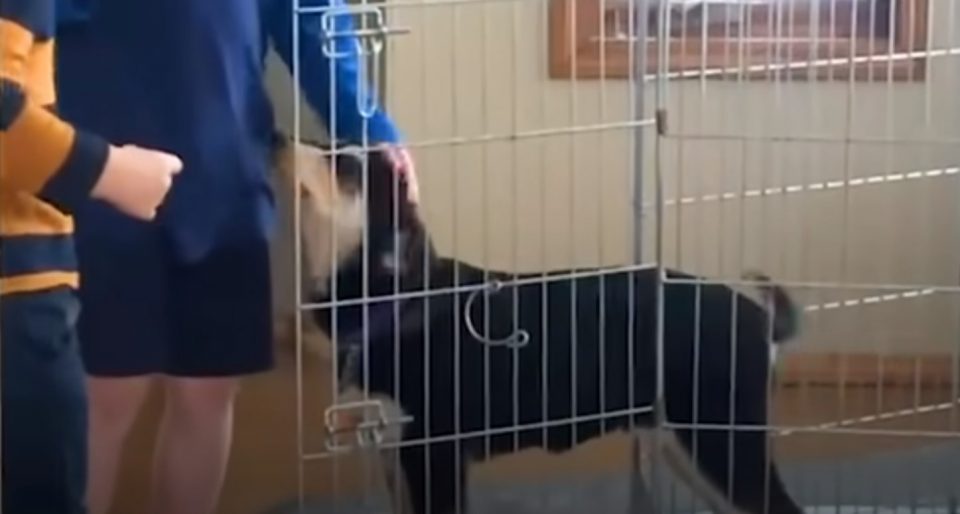Even though being a foster parent to a pup isn’t an easy job, it sure is rewarding!
Helping a pup who needs a bit more love and attention to overcome the difficulties they face in life and finally seeing a smile on their face is one of the best feelings ever.
A feeling that a foster mama named Tamara is well familiar with.
One Scared Pup

“She was hiding in the back of the crate, facing her head the other way. She wouldn’t make eye contact. She was huddled as small as possible,” Tamara told The Dodo.
Even when Tamara went to check up on her the next day, the pup was still sitting at the back of the crate, trying to hide away from the world.

The next day, however, the pup started trusting Tamara more and came to the edge of the crate in order to eat.
She even held eye contact with her foster mom – something that she avoided ever since they met.

“She probably was just thinking like ‘They are feeding me, it’s warm, maybe it’s a safe place!’” she added.
And then, something incredible happened.
Magical Friendship
On one occasion, Tamara’s son decided to approach the pup with some food in his hand. When he got close, he called the pup out, and she came!
“She just all of a sudden ran out, and her tail was wagging and she said hello. He just looked at me like ‘Mom, she said hi!’ So, he was pretty, pretty excited,” said Tamara.

From that point onward, things only got better.
The pup, named Parker, truly came out of her shell and started enjoying every single moment with her foster family.
And, seeing Parker go from a shy pup to one who adores playing with every hooman she meets made Tamara’s heart overflow with joy.

New Life
As soon as Parker arrived at her new house, she immediately settled in.
She loved her new family as well as her new furry sibling, Willow, with whom she clicked the second they met.

Good girl, Parker!
If you’ve ever owned a furry friend, you know the joy they bring to your life. However, just like us, dogs can sometimes fall ill. One common and concerning illness that can affect our canine companions is parvo. Understanding how dogs contract this disease is crucial in safeguarding your pet’s health. So, let’s take a closer look at how dogs come into contact with the parvovirus.
Picture this: your playful pup exploring the world around them, sniffing, and wagging their tail with glee. Little do they know, lurking in their environment could be the potential threat of parvo. Knowing the ins and outs of how dogs get parvo can help you take proactive steps to keep your four-legged friend safe and healthy. Stay tuned to learn more about this vital aspect of canine health.
Understanding Parvovirus in Dogs
Understanding Parvovirus in Dogs is crucial for every dog owner. Parvovirus, commonly known as parvo, is a highly contagious viral illness that affects dogs of all ages, but it mainly impacts puppies under six months old. This virus primarily attacks the gastrointestinal tract and bone marrow of dogs, weakening their immune system and making them susceptible to infections.
How Dogs Contract Parvovirus
Dogs contract Parvovirus through direct contact with an infected dog’s feces or contaminated environments. The virus can survive in the environment for months, making it easy for dogs to pick up the infection by sniffing, licking, or ingesting contaminated objects or surfaces. Puppies are at a higher risk of contracting the virus as their immune systems are not fully developed.
Common Symptoms of Parvovirus
Symptoms of Parvovirus in dogs include severe vomiting, bloody diarrhea, lethargy, loss of appetite, and dehydration. If you notice these symptoms in your dog, it’s essential to seek immediate veterinary care as Parvovirus can be fatal if not treated promptly. Early detection and treatment increase the chances of survival.
Preventing Parvovirus Infection
Preventing Parvovirus infection involves vaccinating your dog against the virus. Puppies should receive a series of vaccinations starting at six to eight weeks of age, with booster shots given at regular intervals. Additionally, avoid taking your dog to areas where unvaccinated dogs frequent and ensure your dog’s living environment is clean and free of fecal contamination.
Conclusion
Understanding how dogs contract Parvovirus and being aware of the symptoms are vital to protecting your furry companion. By vaccinating your dog, practicing good hygiene, and seeking prompt veterinary care if you suspect Parvovirus, you can help safeguard your dog’s health and well-being. Stay informed and proactive to ensure a happy and healthy life for your beloved pet.
Causes of Parvovirus Infection in Dogs
Parvovirus infection in dogs is primarily caused by:
- Direct Contact:
- Infected Dogs: Coming into contact with dogs already infected with parvovirus significantly increases the risk.
- Contaminated Areas: Contact with contaminated environments where the virus is present, such as parks or kennels.
- Ingestion:
- Virus Particles: Dogs can ingest the virus by licking or sniffing contaminated surfaces or objects.
- Fecal-Oral Route:
- Transmission: The virus spreads through an infected dog’s feces and can be easily transmitted through oral contact.
- Maternal Transmission:
- Puppies: Mother dogs can pass the virus to their puppies during pregnancy or nursing, emphasizing the importance of vaccination.
- Immune System Suppression:
- Weakened Immune System: Dogs with weakened immune systems due to stress, malnutrition, or other illnesses are more susceptible to parvovirus infection.
Understanding these causes is crucial in preventing and managing parvovirus infection in dogs. Ensuring proper vaccination, maintaining hygiene, and minimizing exposure to infected animals and environments are key steps to safeguard your furry companion’s health. Prompt veterinary attention is essential if you suspect your dog may have contracted the virus. Taking proactive measures can help protect your dog from this potentially fatal disease.
Symptoms of Parvovirus in Dogs
If your dog contracts Parvovirus, you must be vigilant for the following symptoms:
- Severe Gastrointestinal Issues: Dogs with Parvovirus often experience severe diarrhea, sometimes accompanied by blood.
- Vomiting: Dogs may vomit frequently, and the vomit might contain blood.
- Loss of Appetite: Your dog may show disinterest in food or water.
- Lethargy: A lack of energy, playfulness, or enthusiasm could indicate a problem.
- Fever: Checking your dog’s temperature is crucial as a high fever is a common symptom.
- Dehydration: Watch for signs like sunken eyes, dry gums, and excessive panting as these may indicate dehydration.
- Weight Loss: Sudden weight loss can be a concerning symptom of Parvovirus.
- Weakness: Your dog may appear weak and unsteady on their feet.
Remember, early detection of these symptoms and prompt veterinary care are essential for a better prognosis. If you notice any of these signs in your dog, contact your veterinarian immediately.
Treatment Options for Dogs with Parvovirus
If your dog is diagnosed with Parvovirus, prompt and proper treatment is vital to increase the chances of recovery. Here are some common treatment options for dogs with Parvovirus:
1. Hospitalization:
You’ll need to hospitalize your dog to provide intensive care, including fluid therapy to address dehydration and electrolyte imbalances caused by severe vomiting and diarrhea.
2. Intravenous Fluids:
Administering fluids directly into the vein helps maintain hydration and replace lost fluids due to vomiting and diarrhea, supporting your dog’s overall well-being.
3. Medications:
Your veterinarian may prescribe medications such as anti-nausea drugs, antibiotics to prevent secondary infections, and medication to alleviate diarrhea or vomiting.
4. Nutritional Support:
Feeding tubes or special diets may be necessary, as dogs with Parvovirus often struggle to eat or keep food down. Your vet will recommend the best nutritional support for your dog’s recovery.
5. Monitoring and Nursing Care:
Continuous monitoring of your dog’s vital signs, hydration levels, and overall condition is essential. Providing a warm, quiet, and comfortable environment can aid in your dog’s recuperation.
6. Isolation:
During treatment, your dog will need to be isolated to prevent the spread of the virus to other animals and ensure a controlled environment for recovery.
Remember, timely veterinary intervention and following the prescribed treatment plan are crucial for helping your dog battle Parvovirus and improve their chances of a successful recovery.
Prevention and Vaccination
When it comes to protecting your furry friend from Parvovirus, prevention is key. Here’s what you need to know:
Vaccination
Vaccination is the most effective way to prevent Parvovirus in dogs. Ensure your puppy receives the full series of vaccinations starting at around 6-8 weeks of age. Boosters are essential to maintain immunity, so follow your vet’s recommended schedule.
Keep Vaccinations Up to Date
Stay on top of your dog’s vaccination schedule. Regular boosters are crucial to ensure long-term immunity against Parvovirus. Check with your vet for the appropriate vaccination intervals.
Limit Exposure
Reduce your dog’s exposure to potentially contaminated areas such as dog parks, kennels, and areas frequented by other dogs. Avoid contact with infected animals or their feces to lower the risk of contracting Parvovirus.
Hygiene Practices
Maintain good hygiene practices, including regular cleaning of your dog’s living space, food and water bowls, and grooming tools. Proper hygiene reduces the chances of viral spread and infection.
Consult Your Veterinarian
Always consult your veterinarian for guidance on the best vaccination protocol, especially if you have a new puppy or if you’re unsure about your dog’s vaccination status. Your vet can provide tailored advice based on your dog’s individual needs.
Conclusion
That’s the scoop on how dogs can catch Parvovirus. Remember, prevention is key! Make sure your furry friend is up to date on vaccinations and steer clear of risky areas. Keep an eye out for those symptoms we chatted about earlier, and if you suspect Parvo, get your pup to the vet pronto. With the right care and treatment, your dog can bounce back from this nasty virus. Stay informed, stay proactive, and keep your canine companion safe and healthy.
Frequently Asked Questions
What is Parvovirus in dogs?
Parvovirus in dogs is a highly contagious viral illness that primarily affects puppies. It can be fatal if not treated promptly.
How do dogs contract Parvovirus?
Dogs contract Parvovirus through direct contact with an infected dog or by exposure to contaminated feces, environments, or objects.
What are the symptoms of Parvovirus in dogs?
Symptoms of Parvovirus in dogs include severe gastrointestinal issues, vomiting, loss of appetite, lethargy, fever, dehydration, weight loss, and weakness.
Why is prevention important for Parvovirus?
Prevention is crucial to protect dogs from Parvovirus. Vaccination, hygiene practices, and limiting exposure to contaminated areas are key preventive measures.
What should I do if my dog shows symptoms of Parvovirus?
If your dog shows symptoms of Parvovirus, seek immediate veterinary attention. Treatment may include hospitalization, intravenous fluids, medications, and a prescribed treatment plan.
[no_toc]

Hey there, I’m Janet Brooks, a dog-loving student from California. I’m all about helping pups in need, especially those without homes. Me and my awesome friends work together to give shelter and love to stray dogs. Oh, and I also write blogs about dogs to share helpful info.